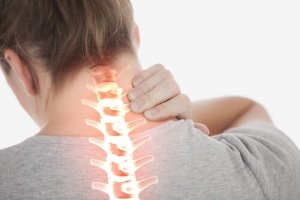Muscular Torticollis: Symptoms and Treatment

Muscular torticollis is a contraction that occurs in the neck area and usually happens due to poor sleep posture. A bad neck position can lead to stiffness and a lot of pain when moving.
As the article Update on acute mechanical cervicalgia points out, muscular torticollis can also occur after exposure to air drafts or forced movements. So, you must take care of your neck to prevent this painful condition.
Congenital Muscular Torticollis

Before addressing the characteristic symptoms of muscular torticollis, we must introduce the term congenital muscular torticollis. This refers to the presence of this condition from the moment a baby is born. Studies also indicate that the condition can derive from a certain deformity at birth. The baby’s sternocleidomastoid muscle is shorter due to problems during birth.
The only solution, in these cases, is to undergo a surgical operation as soon as possible. This is because the body will try to compensate for such shortening of the muscle by causing problems in the spine, for example.
As the newborn grows, his or her head will become more inclined to one side than the other. When forced to straighten it, there’ll be resistance together with slight pain.
Though you can avoid surgery in some cases, it’s the only solution most of the time when a child is born with this condition. In any case, it’s important to follow the instructions from the doctor so that it evolves in the most favorable possible way for the baby.
Read: How to Reduce the Risk of Cervical Osteoarthritis
The Symptoms of Muscular Torticollis
Now that you’ve learned about one type of congenital torticollis, let’s look at the symptoms surrounding the most common version: The one that we all know because we’ve had it at some point during our lives. Also, we’ll tell you how to relieve this condition.
Limited head movement
Muscular torticollis is when you get out of bed after sleeping through the night and feel intense pain in the neck when making a slight movement. Perhaps the head is tilted to one side or there’s a reduction in mobility within the area. If you touch the spot where it hurts you’ll notice how rigid the muscle is.
- In these cases, avoid sudden movements and warm up the neck to control the temperature of the area.
- You may give yourself a gentle massage to reduce discomfort (although it’ll only be momentary).
You may be interested: Seven Telltale Signs You’re Not Drinking Enough Water
Headache
Muscular torticollis can also cause headaches, especially if you’re prone to them. This occurs due to the stiffness of the area and there may also be cervical pain.
In these cases, you should also avoid sudden movements and try to immobilize the area. If that isn’t possible and your work requires mobility, then use a neck brace. However, you must place it immediately and under no circumstances should it increase your pain.
Shoulders at a different height

Finally, a characteristic symptom of torticollis is to have one shoulder slightly higher than the other. This is due to the intense contraction that occurs in the muscle and that forces the head to lean towards one side.
In this case, you can do a very gentle and controlled stretch to relieve your discomfort. Also, you must avoid sudden movements. The best thing you can do is rest as much as you can.
If you choose to use a neck brace, remember it shouldn’t be too tight. It’s not a good idea for the neck to remain even more rigid than it already is, as it’s essential to move it slowly without abruptness.
Additionally, keep in mind that torticollis improves as the days go by. In fact, it usually lasts about three days. So, with proper care, your problem will disappear sooner than you expect.
Maintaining good posture while you sleep, as well as acquiring a proper pillow, can reduce your chances of muscle torticollis. In any case, know that everyone will experience it at some point, and it’s nothing to be concerned about.
All cited sources were thoroughly reviewed by our team to ensure their quality, reliability, currency, and validity. The bibliography of this article was considered reliable and of academic or scientific accuracy.
- Ankha, M. E. A., Nascimento, R., Raldi, F., De Moraes, M., Ribeiro, Z., & Dos Santos, L. (2017). Traumatic bone cyst and congenital muscular torticollis: association or a chance?. Revista española de cirugía oral y maxilofacial: Publicación Oficial de la Sociedad Española de Cirugía Oral y Maxilofacial, 39(1), 46-49.
- Barraquer-Bordas, L.. (1966). Los transtornos del movimiento, de la postura y del tono por patologia extrapiramidal. Arquivos de Neuro-Psiquiatria, 24(2), 122-139. https://dx.doi.org/10.1590/S0004-282X1966000200007
- González Gil, José Manuel, González Salgado, Omar, & Barranco Martínez, Luis Felipe. (2001). Tortícolis infantil: Nuevas perspectivas en su tratamiento. Revista Cubana de Ortopedia y Traumatología, 15(1-2), 65-70. Recuperado en 12 de abril de 2019, de http://scielo.sld.cu/scielo.php?script=sci_arttext&pid=S0864-215X2001000100013&lng=es&tlng=es.
- Robles Gálvez, C. N. (2018). Enfoque fisioterapéutico en el tortícolis muscular congénito.
This text is provided for informational purposes only and does not replace consultation with a professional. If in doubt, consult your specialist.








